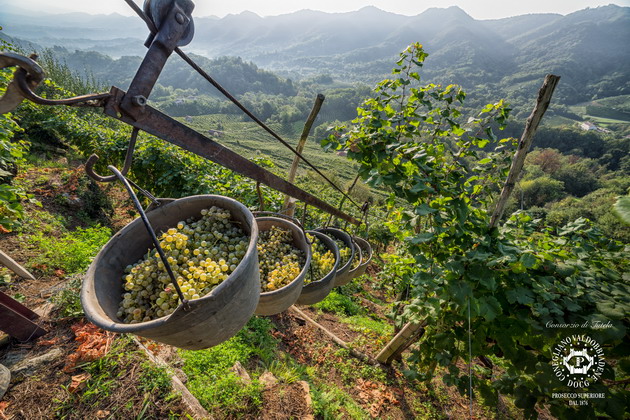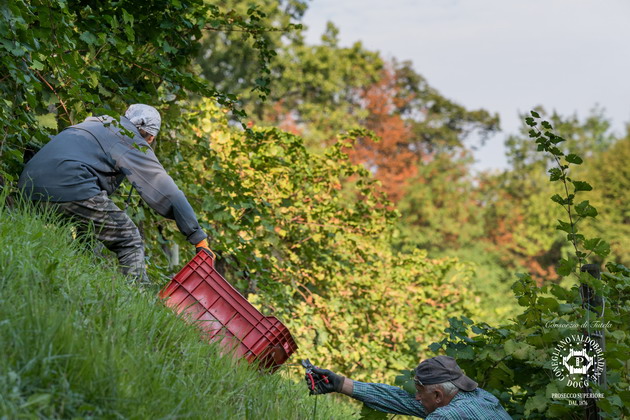Prosecco has become, possibly, the most sought after sparkling wine after Champagne.
It showcases wonderful aromatics and freshness, as well as value. As one might imagine, there is still a fairly broad range of styles that this tiny northeastern appellation in Italy can offer.
What makes Prosecco distinct from other sparkling wines are the well-preserved aromatics and the perceived “creaminess” the gentle carbonation creates on the palate.
This distinctiveness is partially due to the obscure family of grape varietals used, but these flavours can only be harnessed so effectively because of the innovative production method behind Prosecco.
The traditional practice for making sparkling wine is a laborious, finicky, and time-consuming ritual that takes years to implement effectively to produce something worthwhile.
After the initial fermentation of the base wine, the wine is re-fermented in the bottle over an extended period.
Contact with the yeast sediment inside the bottle imparts distinct flavours one associates with Cava, French Cremant, and (most significantly) Champagne.
Prosecco is the most popular iteration of the Charmat/Martinotti method; named for the French and Italian innovators who first employed this production method. This process cuts the time needed for fermenting a sparkling wine from years to months.
When wine ferments, the yeasts release carbon dioxide and ethanol. In still wine fermentation, the carbon dioxide escapes. The key to making sparkling wine is to ferment the wine under controlled pressure, so that the carbon dioxide dissolves back into the wine – only to be released once you pop the cork.
The genius of the Charmat/Martinotti method is that once the wine is fermented into base wine, it is placed in a sealed vat that traps the carbon dioxide of the introduced secondary fermentation. It is less labour intensive, less costly, and there is less spoilage than traditional sparkling production methods.
As the understanding of modern chemistry and biology improved, so did the advancement of agriculture, viticulture, and fermentation. The discovery of micro-organisms and the invention of pasteurization led to widespread use of sealed vats that were easily maintained and temperature controlled. These prevent spoilage in food and wine.
When exposed to air, wine is susceptible to oxidation and the aromas diffuse away until there is nothing left. Similarly, uncontrolled exposure of unfermented grape must (juice, skins, seeds) to the air can also cause premature oxidation, but it can also lead to biological infection. Both of these can result in ruining the wine.
The method used to produce Prosecco mitigates this problem, although this method also has a distinct effect on what the finished wine will taste like.
The tank method also has the added advantage of making it easier to avoid the wine being in contact with the dead yeast cells (the lees). In traditional sparkling production such as Spanish Cava and Champagne, the wine is intentionally re-fermented in the bottle on top of the yeast cells to provide complex biscuit and dough notes.
Generally, Proseccos minimize or eliminate lees aging. Their style is vastly different than Champagne and other traditional sparklings.
Prosecco makers want their wine to be youthful and vibrantly laden with fresh fruit flavours. They do not want to stifle the wonderful fruit the Glera grape provides for the wine.
Usually, the pressurized tanks used to ferment the base wine into Prosecco are kept as cool as the winemaker feels comfortable. The cooler the ferment, the more vibrant the aromatics coaxed out of the wine.
These techniques are so modern, it sometimes seems hard to imagine how wine must have been made before technology answered every problem. This region has its own traditions, which continue to be passed down.
Prosecco was eponymously named for a city near Karst, along the Slovenian and Italian border. Prosecho, as it was known from the eighteenth to the early twentieth century, was generally only lightly fizzy.
Moscato D’Asti is a fair contemporary example of what Prosecho tasted like – gentle carbonation and slight residual sweetness.
Clever winemakers had developed their own version of the ‘ancestral method’ of producing wine, prior to the invention of pressurized tanks.
The wine was fermented once in the bottle, with only a slight carbonation captured and with the yeasty lees left in the bottle. The lees would impart biscuit aromas and a turbid cloudiness that would be absent in modern Prosecco.
The variety of styles of Prosecco may have changed over the past two hundred years, but there is still plenty of tradition behind the creation of this unique sparkling.
There are apparently still rare examples of ancestral method Prosecco being made today under the labeling term ‘Col Fondo.’ They’re extremely rare outside of Treviso and are a popular “bucket-list” wine to many sommeliers.
Col Fondo has nothing to do with Italian DOC(G) appellation laws. It is the reflection of local growers in the delineated Prosecco areas to preserve a cultural tradition.
There is something special about making as close a contact to the original tradition behind a wine’s style. It gives you a connection with the people and culture that bore it.
Even if wines like this challenge your perception of what good Prosecco is, the historical significance alone should be reason enough to try it. After all, the difference between strange and unique is merely a subjective opinion.
Modern Prosecco comes in three styles of fizziness: spumante, frizzante, and tranquillo/fermo. Spumante, the most common, is the fizziest and is fermented dry.
The bubbles in frizzante tend to be less aggressive and subside shortly after pouring. Tranquillo, or fermo, is the still form of Prosecco, but unfortunately it is rarely exported to international markets in significant quantities.
These styles come in a variety of sweetness levels as well, though they generally tend to be on the drier side.
Different labeling terms (brut, dry, extra-dry) are used to qualify different sweetness levels and they can be misleading, so take note.
Prosecco with up to 12 g/L of residual sugar is labeled as ‘brut,’ the driest category.
‘Extra-dry’ denotes what the rest of the winemaking world would call a demi-sec or an off-dry, at between 12-20 g/L.
Curiously, the sweetest category is labeled as ‘dry’ and can have above 20 g/L.
It is actually much easier to find varying sweetnesses and bubbliness in Prosecco than it is in other types of sparkling wine.
Demi-sec Champagne is quite uncommon, but extra-dry and dry Prosecco (both comparable in sweetness) are extremely easy to find.
This makes it easy to find the appropriate choice for your tastes as well as for food pairing and cocktails. Astoria Prosecco would be an excellent choice for a cocktail Prosecco.
Sparkling wines in general pair with a great variety of cuisine – everything from seafood to junk food. To do Prosecco justice, though, look for something that would adequately contrast the fragrant, fruity nature of this style of sparkling.
Delicately seasoned crab would be a fantastic choice. Sometimes crab can be over seasoned. Let the natural sweetness of the meat to shine through. If crab is too expensive, imitation crab with kimchi or in sushi is just light enough to pair smartly.
Not a lot of people take some more simple or everyday pairings seriously. Prosecco and potato chips demonstrates that you shouldn’t focus only on high cuisine for pairing ideas.
Prosecco’s fresh lick of acidity cuts through the oily nature of chips and would work equally as well with roasted chestnuts.
I also strongly encourage trying sparkling Prosecco with Kraft Dinner (especially the sharp cheddar).
If you are feeling particularly fancy, cut up some hot dogs in your KD. Ketchup is still out of the question, though. Don’t be ridiculous ;)
If KD and hot dogs have little allure to you, Canadian grey-owl cheese would make an intriguing pairing. The outside of the cheese is coated with vegetable ash – a piercing flavour that Prosecco easily contrasts and cleanses off the palate.
If cocktails are your style, bellinis are fantastic on Christmas morning or to begin parties. They’re extremely simple and match the creamy mousse of lighter sparklings, like Prosecco.
One third sparkling to two thirds peach juice is ideal, but Bellinis can also be made with guava and mango juice to similar effect.
Place an hibiscus flower at the bottom of a glass of Prosecco and watch the red syrup diffuse and settle at the bottom of the glass – giving it a sunrise effect.
Most people are also familiar with the Italian predilection with herb liqueurs, which have a satisfying savoury quality well suited to cold nights.
Cinzano, amber vermouth with savoury/smokey aromatics, makes a classic Italian cocktail when mixed with tonic. Replacing the tonic with Prosecco not only gives the vermouth some levity and fruit, but gives it a more appealing, modern appearance.
Sangria or punch is always a good way to accommodate a large group of people with something light and easy to consume.
Usually, in white sangria, bubbliness is added with Perrier or soda. The bubbles in sparkling are more fine and last longer than soda, which is gasified cheaply.
You also kill two birds with one stone – the wine and the bubbles added simultaneously. Cranberry, orange, and cinnamon provide a really nice holiday flavour, while keeping the sangria somewhat traditional.














